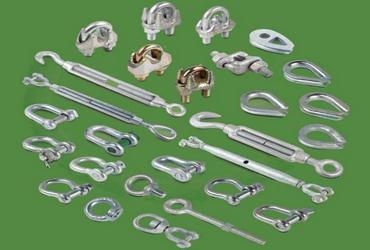Regarding rigging hardware

Common Types of Rigging Hardware
1. Shackles
Used to connect lifting slings, chains, or ropes to loads or lifting equipment.
Types: Anchor shackles (bow), chain shackles (D-shape), screw pin, bolt-type.
Example: G209 screw pin anchor shackle.
2. Hooks
Attach directly to loads or slings for lifting.
Types: Eye hooks, clevis hooks, swivel hooks, self-locking hooks.
Applications: Crane lifting, chain slings, towing.
3. Master Links
Serve as the top connection point in multi-leg chain sling assemblies.
Example: G80 forged master link.
Use: Distributes the load among multiple sling legs.
4. Wire Rope Clips
Used to form loops at the end of wire ropes.
Components: U-bolt, saddle, and nuts.
Important: Must be installed in the correct orientation for safety.
5. Turnbuckles
Adjust tension and length in ropes, cables, and tie rods.
End Types: Jaw-to-jaw, eye-to-eye, hook-to-eye.
Use: Tensioning guy wires, rigging systems, and load supports.
6. Eye Bolts and Swivel Hoist Rings
Attach lifting slings or hooks to loads.
Eye Bolts: Suitable for straight lifts only.
Hoist Rings: Swivel to allow angular lifting.
7. Snatch Blocks and Pulleys
Used to redirect or multiply pulling force using ropes or cables.
Function: Reduce load on winches or cranes and change pulling direction.
Applications of Rigging Hardware
Rigging hardware is indispensable in a variety of fields:
Construction: Hoisting steel beams, concrete panels, and equipment.
Maritime: Securing cargo, hoisting anchors, and mooring.
Industrial: Moving heavy machinery or equipment within factories.
Entertainment: Hanging lighting rigs or stage structures.
Oil and Gas: Lifting components on offshore rigs and platforms.
Best Practices for Using Rigging Hardware
To ensure safe and effective use of rigging hardware:
Inspection: Regularly check for wear, corrosion, deformation, or cracks.
Match the WLL: Always use hardware rated for the intended load.
Use the Right Hardware: Ensure components are compatible in size, shape, and capacity.
Follow Manufacturer Guidelines: Proper use and installation are critical.
Avoid Side Loading: Rigging components should be loaded in-line to prevent bending or failure.
Training: Only trained personnel should assemble and inspect rigging systems.
Conclusion
Rigging hardware is the foundation of safe and effective lifting operations.
Whether you're hoisting a steel beam on a construction site or securing cargo aboard a vessel, the right hardware ensures reliability, efficiency, and—most importantly—safety.
Choosing certified, high-quality components and adhering to industry best practices is key to preventing accidents and equipment failure.

 Send Email
Send Email +86 17056906088
+86 17056906088